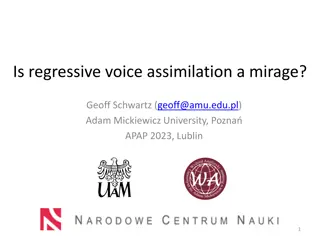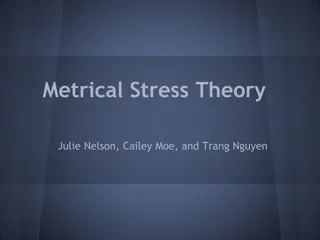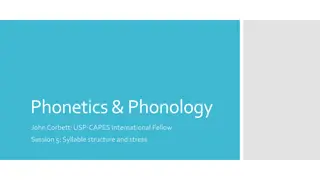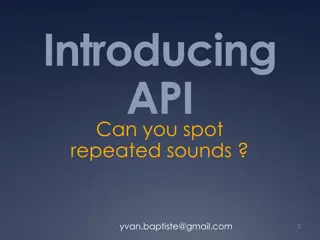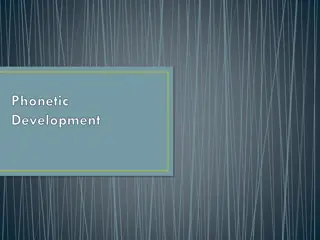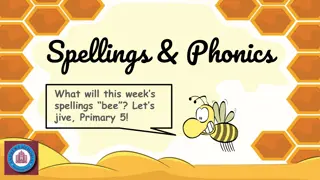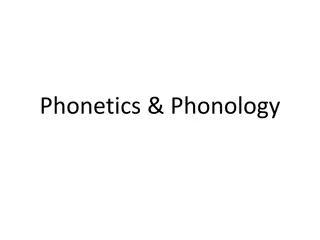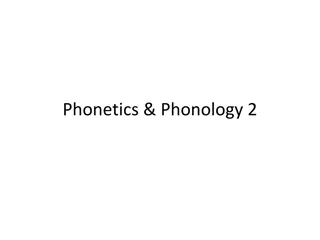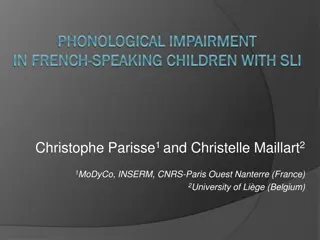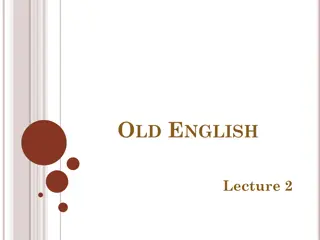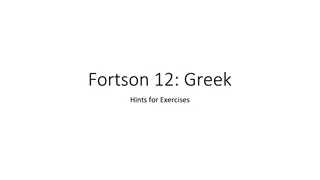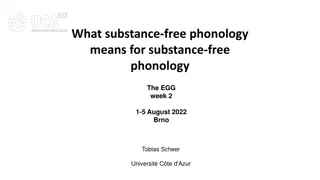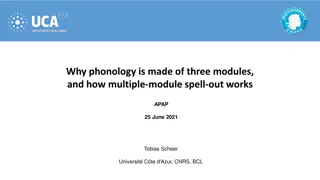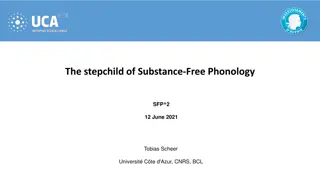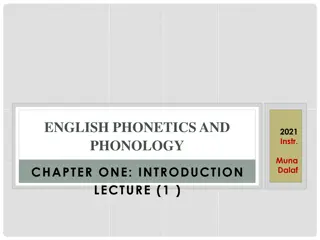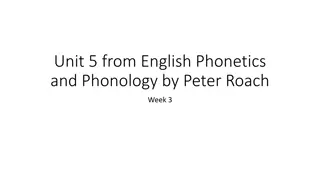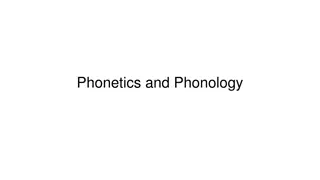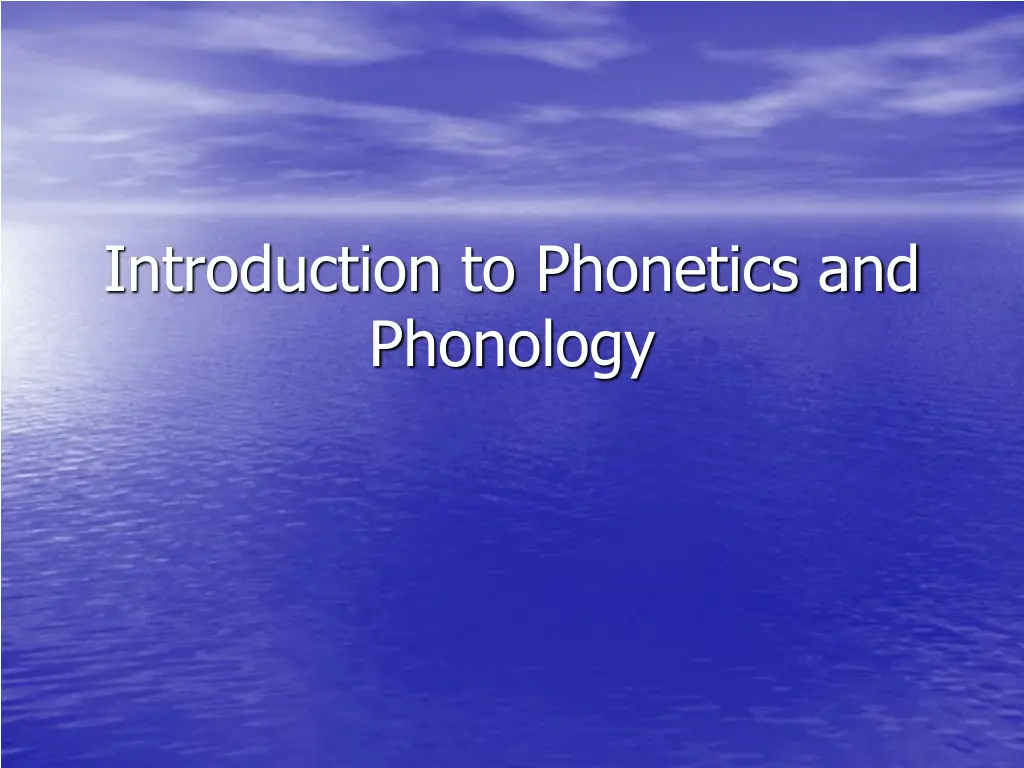
Understanding Plosive Consonants in Phonetics
Explore the world of plosive consonants in phonetics known as stop consonants. Discover how sounds like /p, b, t, d, k, g/ are articulated using different speech organs like lips, tongue, and palate. Learn about the unique features and articulation of bilabial and alveolar plosives, their positions in words, and variations based on positions in detail.
Download Presentation

Please find below an Image/Link to download the presentation.
The content on the website is provided AS IS for your information and personal use only. It may not be sold, licensed, or shared on other websites without obtaining consent from the author. If you encounter any issues during the download, it is possible that the publisher has removed the file from their server.
You are allowed to download the files provided on this website for personal or commercial use, subject to the condition that they are used lawfully. All files are the property of their respective owners.
The content on the website is provided AS IS for your information and personal use only. It may not be sold, licensed, or shared on other websites without obtaining consent from the author.
E N D
Presentation Transcript
Introduction to Phonetics and Phonology
Plosives also called STOP CONSONANTS the breath is completely stopped at some point in the mouth and then released with a slight explosion speech organs which may form plosives: lips (bilabial plosives), tip of the tongue (alveolar plosives), back of the tongue (velar plosives) all six plosives (/p, b, t, d, k, g/) may occur at the beginning of words, in the middle of words and at the end of words these positions are important because plosives are articulated differently in different positions
/p, b/ bilabial plosives the lips are closed firmly, the soft palate is raised so that the air cannot go through the nose, but is trapped in the mouth for a while when the lips open suddenly, the air rushes out with a slight explosion or a popping noise before the lips open, other speech organs assume the position for the following sound, whether it be a vowel or a consonant
/p/ - strong, voiceless /b/ - weak, voiced when /p/ is found at the beginning of a word, it has a special feature ASPIRATION e.g. pull, pot, put, pat, pet, pit /p/ between vowels is less aspirated e.g. happy, paper, supper, apply in final position, /p/ is also less aspirated e.g. rip, rope, tap, cap, wrap /b/ never has aspiration e.g. book, bar, back, bell, bit, bean
/p/ at the end of words shortens the preceding vowel, whereas /b/ is weak and lengthens the preceding vowel consonant clusters of /p/ or /b/ and other plosives are produced a little differently (topic of our next class)
/t, d/ alveolar plosives the tip of the tongue is pressed against the alveolar ridge the soft palate is raised, the breath does not go into the nasal cavity, it stays trapped in the mouth for a while the sides of the tongue are firmly pressed against the sides of the palate so the air cannot pass over the sides of the tongue the tip of the tongue is lowered suddenly and the air rushes out with a slight explosion or a popping noise
/t/ is strong, voiceless and aspirated e.g. top, tin, tan, ten, ton /d/ is short, weak and never aspirated when /t/ occurs word-medially, it loses some aspiration in final position, /t/ is also less aspirated and shortens the vowel before it /d/ is weak, makes very little noise but lengthens the vowel that precedes it when followed by other plosives or /m, n, l/, /t/ and /d/ are pronounced differently (topic of our next class)
/k, g/ velar plosives the back of the tongue is in contact with the soft palate, which is raised, so the air cannot go into the nasal cavity and is trapped in the mouth when the tongue is lowered suddenly from the soft palate, the breath rushes out of the mouth with a slight explosion or a popping sound
/k/ is strong, voiceless and aspirated e.g. cot, cat, cart, kill, keep when /k/ occurs between vowels, the aspiration is weaker or even absent /g/ is weak, voiced and has no aspiration in final position, /k/ shortens the vowel before it, /g/ lengthens the vowel before it when /k/ and /g/ are followed by other plosives or /m/ or /n/, these sounds are produced in a different manner (topic of our next class)
Affricates /t , d / these two phonemes are articulated both with friction and with explosion of air tip of the tongue touches the back part of the alveolar ridge the soft palate is raised so that air is trapped in the mouth for a short time tip of the tongue moves away from the alveolar ridge a little and then the tongue comes to the position for / / or / /, when friction is heard friction is not that long with these two phonemes
palato-alveolar affricates /t , d / are not as strong as Serbian / / and /d /, they are much softer /t / is strong and voiceless /d / is weak and voiced in final position, /t / shortens the preceding vowel, whereas /d / lengthens the preceding vowel
Glides all three consonants produced with a quick, smooth, non-friction glide towards the vowel that follows /j, w, r/
/j/ this consonant is a quick glide from the position of /i:/ or / / or any other vowel sometimes called a semi-vowel phonetically like a vowel (articulated in such a way), but phonologically like a consonant (it only occurs before vowel phonemes) voiced palatal sound palatal glide
/w/ this consonant is a quick glide from the position of /u:/ or / / or any other vowel that follows more difficult to pronounce than /j/, because many languages, including Serbian, do not have it a difference must be made between /v/ and /w/ lips are noticeably rounded! bilabial glide /w/ does not occur in word-final positions wh-words in some dialects of English pronounced with / / (where, which, why)
/r/ the tongue is curved, the tip is pointing towards the hard palate the tip of the tongue is not close enough to the palate to produce friction the lips are quite rounded, especially when /r/ is word-initial the soft palate is raised, voiced air flows quietly between the tip of the tongue and palate without friction palato-alveolar glide
in RP /r/ is only pronounced before vowels, never before consonants when a word ending in r in spelling is followed by another word which begins in a vowel, then /r/ is pronounced e.g. never again /nev r LINKING R sometimes /r/ is heard when there is no equivalent in spelling e.g. Africa and Asia / INTRUSIVE R some speakers can be heard saying such phrases, but it is not a preferred way of usage gen/ /
Bilabial Labio- dental Dental Alveolar Palato- alveolar Palatal Velar Glottal Place of articulation Manner of articulation Plosive p, b t, d k, g , , Fricative f, v s, z h t , d Affricate Nasal m n Lateral l Glide w r j

